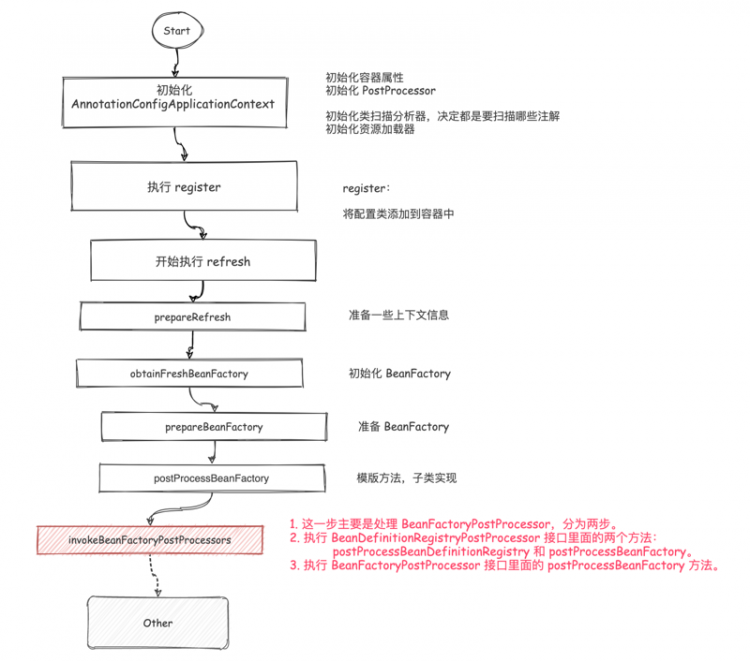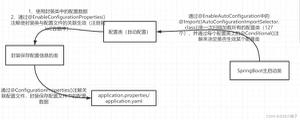Spring AOP @Before @Around @After 等 advice 的执行顺序
本文内容纲要:
- 前提- 情况一: 一个方法只被一个Aspect类拦截
- 情况二: 同一个方法被多个Aspect类拦截
- 注意点
用过spring框架进行开发的人,多多少少会使用过它的AOP功能,都知道有**@Before**、@Around和**@After等advice。最近,为了实现项目中的输出日志和权限控制这两个需求,我也使用到了AOP功能。我使用到了@Before**、@Around这两个advice。但在,使用过程中,却对它们的执行顺序并不清楚。为了弄清楚在不同情况下,这些advice到底是以怎么样的一个顺序进行执行的,我作了个测试,在此将其记录下来,以供以后查看。
前提
- 对于AOP相关类(aspect、pointcut等)的概念,本文不作说明。
- 对于如何让spring框架扫描到AOP,本文也不作说明。
情况一: 一个方法只被一个Aspect类拦截
当一个方法只被一个Aspect拦截时,这个Aspect中的不同advice是按照怎样的顺序进行执行的呢?请看:
添加 PointCut类
该pointcut用来拦截test包下的所有类中的所有方法。
package test;import org.aspectj.lang.annotation.Pointcut;
public class PointCuts { @Pointcut(value = "within(test.*)") public void aopDemo() { } }
添加Aspect类
该类中的advice将会用到上面的pointcut,使用方法请看各个advice的value属性。
package test;import org.aspectj.lang.JoinPoint;
import org.aspectj.lang.ProceedingJoinPoint; import org.aspectj.lang.annotation.*; import org.springframework.stereotype.Component; @Component @Aspect public class Aspect1 { @Before(value = "test.PointCuts.aopDemo()") public void before(JoinPoint joinPoint) { System.out.println("[Aspect1] before advise"); } @Around(value = "test.PointCuts.aopDemo()") public void around(ProceedingJoinPoint pjp) throws Throwable{ System.out.println("[Aspect1] around advise 1"); pjp.proceed(); System.out.println("[Aspect1] around advise2"); } @AfterReturning(value = "test.PointCuts.aopDemo()") public void afterReturning(JoinPoint joinPoint) { System.out.println("[Aspect1] afterReturning advise"); } @AfterThrowing(value = "test.PointCuts.aopDemo()") public void afterThrowing(JoinPoint joinPoint) { System.out.println("[Aspect1] afterThrowing advise"); } @After(value = "test.PointCuts.aopDemo()") public void after(JoinPoint joinPoint) { System.out.println("[Aspect1] after advise"); } }
添加测试用Controller
添加一个用于测试的controller,这个controller中只有一个方法,但是它会根据参数值的不同,会作出不同的处理:一种是正常返回一个对象,一种是抛出异常(因为我们要测试**@AfterThrowing**这个advice)
package test;import test.exception.TestException;
import org.springframework.http.HttpStatus; import org.springframework.web.bind.annotation.*; @RestController @RequestMapping(value = "/aop") public class AopTestController { @ResponseStatus(HttpStatus.OK) @RequestMapping(value = "/test", method = RequestMethod.GET) public Result test(@RequestParam boolean throwException) { // case 1 if (throwException) { System.out.println("throw an exception"); throw new TestException("mock a server exception"); } // case 2 System.out.println("test OK"); return new Result() {{ this.setId(111); this.setName("mock a Result"); }}; } public static class Result { private int id; private String name; public int getId() { return id; } public void setId(int id) { this.id = id; } public String getName() { return name; } public void setName(String name) { this.name = name; } } }
测试 正常情况
在浏览器直接输入以下的URL,回车:
http://192.168.142.8:7070/aoptest/v1/aop/test?throwException=false我们会看到输出的结果是:
[Aspect1] around advise 1[Aspect1] before advise test OK [Aspect1] around advise2 [Aspect1] after advise [Aspect1] afterReturning advise
测试 异常情况
在浏览器中直接输入以下的URL,回车:
http://192.168.142.8:7070/aoptest/v1/aop/test?throwException=true我们会看到输出的结果是:
[Aspect1] around advise 1[Aspect1] before advise throw an exception [Aspect1] after advise [Aspect1] afterThrowing advise
结论
在一个方法只被一个aspect类拦截时,aspect类内部的 advice 将按照以下的顺序进行执行:
正常情况:
异常情况:
情况二: 同一个方法被多个Aspect类拦截
此处举例为被两个aspect类拦截。
有些情况下,对于两个不同的aspect类,不管它们的advice使用的是同一个pointcut,还是不同的pointcut,都有可能导致同一个方法被多个aspect类拦截。那么,在这种情况下,这多个Aspect类中的advice又是按照怎样的顺序进行执行的呢?请看:
pointcut类保持不变
添加一个新的aspect类
package test;import org.aspectj.lang.JoinPoint;
import org.aspectj.lang.ProceedingJoinPoint; import org.aspectj.lang.annotation.*; import org.springframework.stereotype.Component; @Component @Aspect public class Aspect2 { @Before(value = "test.PointCuts.aopDemo()") public void before(JoinPoint joinPoint) { System.out.println("[Aspect2] before advise"); } @Around(value = "test.PointCuts.aopDemo()") public void around(ProceedingJoinPoint pjp) throws Throwable{ System.out.println("[Aspect2] around advise 1"); pjp.proceed(); System.out.println("[Aspect2] around advise2"); } @AfterReturning(value = "test.PointCuts.aopDemo()") public void afterReturning(JoinPoint joinPoint) { System.out.println("[Aspect2] afterReturning advise"); } @AfterThrowing(value = "test.PointCuts.aopDemo()") public void afterThrowing(JoinPoint joinPoint) { System.out.println("[Aspect2] afterThrowing advise"); } @After(value = "test.PointCuts.aopDemo()") public void after(JoinPoint joinPoint) { System.out.println("[Aspect2] after advise"); } }
测试用Controller也不变
还是使用上面的那个Controller。但是现在 aspect1 和 aspect2 都会拦截该controller中的方法。
下面继续进行测试!
测试 正常情况
在浏览器直接输入以下的URL,回车:
http://192.168.142.8:7070/aoptest/v1/aop/test?throwException=false我们会看到输出的结果是:
[Aspect2] around advise 1[Aspect2] before advise [Aspect1] around advise 1 [Aspect1] before advise test OK [Aspect1] around advise2 [Aspect1] after advise [Aspect1] afterReturning advise [Aspect2] around advise2 [Aspect2] after advise [Aspect2] afterReturning advise
但是这个时候,我不能下定论说 aspect2 肯定就比 aspect1 先执行。
不信?你把服务务器重新启动一下,再试试,说不定你就会看到如下的执行结果:
[Aspect1] around advise 1[Aspect1] before advise
[Aspect2] around advise 1
[Aspect2] before advise
test OK
[Aspect2] around advise2
[Aspect2] after advise
[Aspect2] afterReturning advise
[Aspect1] around advise2
[Aspect1] after advise
[Aspect1] afterReturning advise
也就是说,这种情况下, aspect1 和 aspect2 的执行顺序是未知的。那怎么解决呢?不急,下面会给出解决方案。
测试 异常情况
在浏览器中直接输入以下的URL,回车:
http://192.168.142.8:7070/aoptest/v1/aop/test?throwException=true我们会看到输出的结果是:
[Aspect2] around advise 1[Aspect2] before advise [Aspect1] around advise 1 [Aspect1] before advise throw an exception [Aspect1] after advise [Aspect1] afterThrowing advise [Aspect2] after advise [Aspect2] afterThrowing advise
同样地,如果把服务器重启,然后再测试的话,就可能会看到如下的结果:
[Aspect1] around advise 1[Aspect1] before advise [Aspect2] around advise 1 [Aspect2] before advise throw an exception [Aspect2] after advise [Aspect2] afterThrowing advise [Aspect1] after advise [Aspect1] afterThrowing advise
也就是说,同样地,异常情况下, aspect1 和 aspect2 的执行顺序也是未定的。
那么在 情况二 下,如何指定每个 aspect 的执行顺序呢?
方法有两种:
- 实现org.springframework.core.Ordered接口,实现它的**getOrder()**方法
- 给aspect添加**@Order**注解,该注解全称为:org.springframework.core.annotation.Order
不管采用上面的哪种方法,都是值越小的 aspect 越先执行。
比如,我们为 apsect1 和 aspect2 分别添加 @Order 注解,如下:
@Order(5)@Component @Aspect public class Aspect1 { // ... } @Order(6) @Component @Aspect public class Aspect2 { // ... }
这样修改之后,可保证不管在任何情况下, aspect1 中的 advice 总是比 aspect2 中的 advice 先执行。如下图所示:
注意点
如果在同一个 aspect 类中,针对同一个 pointcut,定义了两个相同的 advice(比如,定义了两个 @Before),那么这两个 advice 的执行顺序是无法确定的,哪怕你给这两个 advice 添加了 @Order 这个注解,也不行。这点切记。
对于**@Around**这个advice,不管它有没有返回值,但是必须要方法内部,调用一下 pjp.proceed();否则,Controller 中的接口将没有机会被执行,从而也导致了 @Before这个advice不会被触发。比如,我们假设正常情况下,执行顺序为”aspect2 -> apsect1 -> controller”,如果,我们把 aspect1中的@Around中的 **pjp.proceed();**给删掉,那么,我们看到的输出结果将是:
[Aspect2] around advise 1
[Aspect2] before advise [Aspect1] around advise 1 [Aspect1] around advise2 [Aspect1] after advise [Aspect1] afterReturning advise [Aspect2] around advise2 [Aspect2] after advise [Aspect2] afterReturning advise
从结果可以发现, Controller 中的 接口 未被执行,aspect1 中的 @Before advice 也未被执行。
来源:http://blog.csdn.net/rainbow702/article/details/52185827
此文章来源于网络,版权不归本人所有。
本文内容总结:前提,情况一: 一个方法只被一个Aspect类拦截,情况二: 同一个方法被多个Aspect类拦截,注意点,
原文链接:https://www.cnblogs.com/panchanggui/p/10762147.html
以上是 Spring AOP @Before @Around @After 等 advice 的执行顺序 的全部内容, 来源链接: utcz.com/z/362911.html









